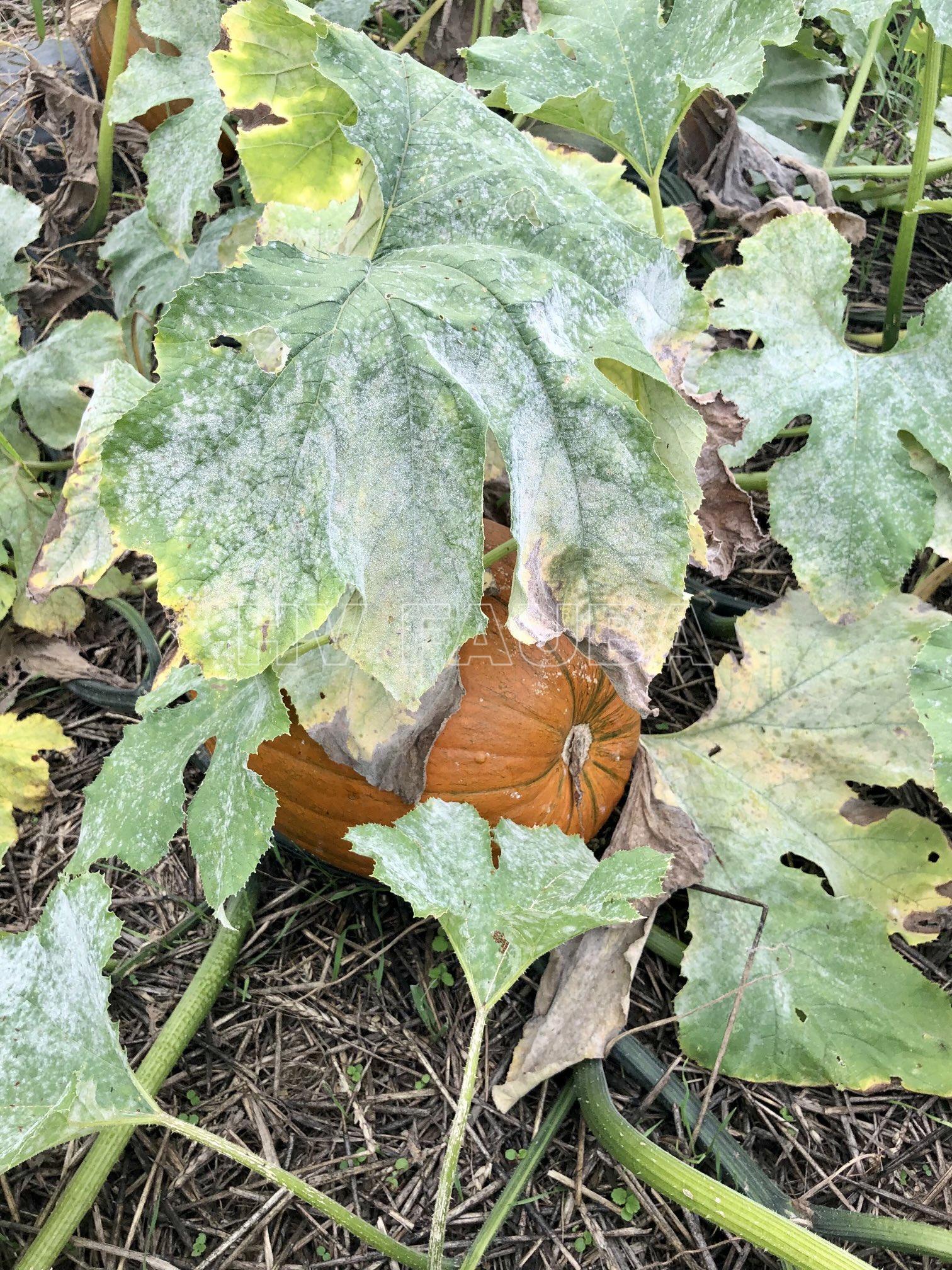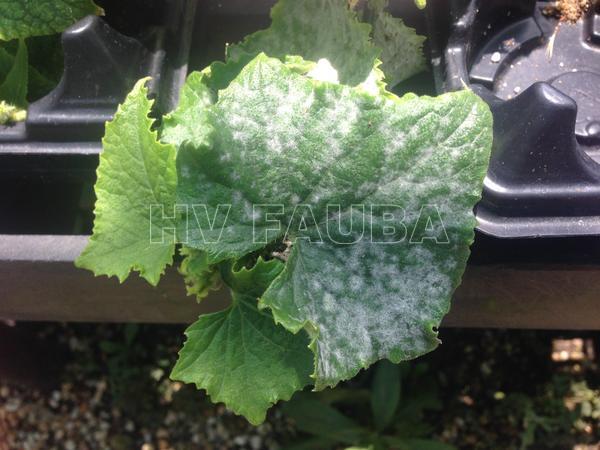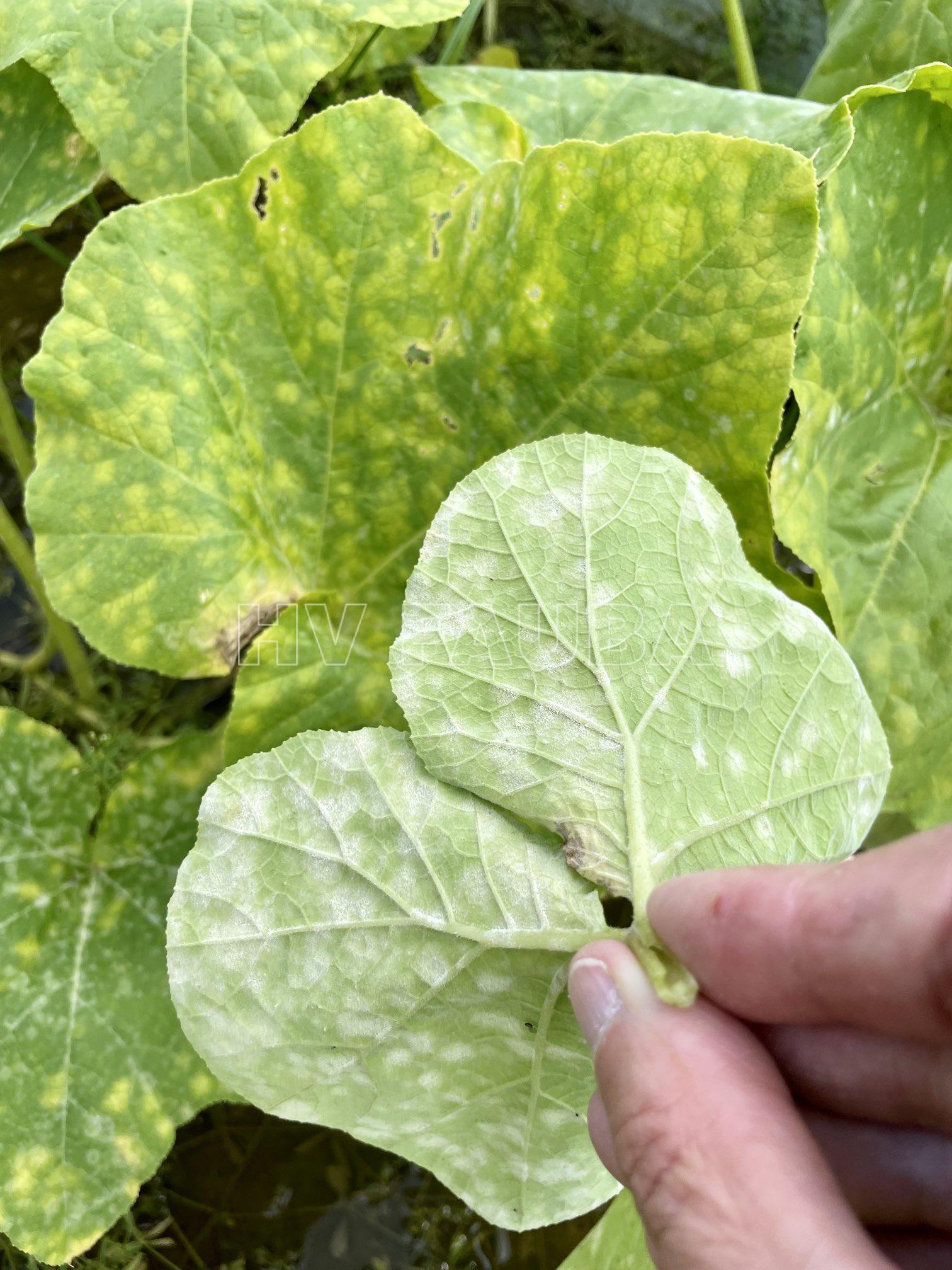.
Condición fitosanitaria: Presente
Grupo de cultivos: Frutales
Especie hospedante: Vid (Vitis vinifera)
Rango de hospedantes: Asteracea, Cucurbitaceae, Lamiaceae, Scrophulariaceae, Solanaceae, Verbenaceae.
Etiología: Hongo. Biotrófico
Agente causal:
Podosphaera xanthii (Castagne) U. Braun & Shishkoff, 2000,
syn. Podosphaera fusca (Fr.) Braun & Shishkoff,
Golovinomyces cichoracearum (sin. Erysiphe cichoracearum)
.
Taxonomía:
Fungi > Dikarya > Ascomycota > Pezizomycotina > Leotiomycetes > Erysiphales > Erysiphaceae> Podosphaera
Fungi > Dikarya > Ascomycota > Pezizomycotina > Leotiomycetes > Erysiphales > Erysiphaceae > Golovinomyces
.
.
Antecedentes
Numerosos cultivos de hortalizas son susceptibles a los hongos patógenos causantes de oídios, pero las cucurbitáceas son posiblemente el grupo más afectado. Podosphaera fusca (sinónimo Podosphaera xanthii) es el principal agente causal del oídio de las cucurbitáceas y uno de los factores limitantes más importantes para la producción de cucurbitáceas en todo el mundo. Aunque se han invertido grandes esfuerzos en el control de enfermedades, por el contrario, se desconocen muchos aspectos básicos de la biología de P. fusca.
.
Síntomas
Se desarrollan colonias blancas (micelio) en la superficie de las hojas, los pecíolos y los tallos. En condiciones ambientales favorables, las colonias se fusionan y el tejido del hospedante se vuelve clorótico y generalmente envejece temprano.
.
- Autor: Zachariah Hansen
- Autor: North Carolina State Veggie Pathology
- Autor: Dr. Lina Quesada, NC State Vegetable Pathology Lab
.
Diagnóstico
El diagnóstico mediante características morfológicas incluye el reconocimiento de: micelio superficial persistente; conidios en cadenas (conidióforos libres), hialinos, elipsoides a ovoides o doliformes, alrededor de 24–40 × 15–22 µm, con cuerpos de fibrosina cilíndricos o cónicos, que a menudo germinan en una cara lateral y producen un tubo germinativo claviforme ancho y un pie cilíndrico; conidióforos erectos no ramificados; cleistothecio globoso, mayoritariamente de 70 a 100 µm de diámetro, marrón oscuro a negro; un asco por cleistotecio con ocho ascosporas.
.
Manejo Integrado
* Uso de variedades resistentes (cuando estuvieran disponibles)
* Control químico con fungicidas. Se ha documentado resistencia en poblaciones de P. fusca a algunos ingredientes activos.
.
- Autor: Ed Sikora
.
.
.
Bibliografía
Braun U (2012) The impacts of the discontinuation of dual nomenclature of pleomorphic fungi: the trivial facts, problems, and strategies. IMA Fungus 3: 81–86. doi: 10.5598/imafungus.2012.03.01.08
Braun U (2013) (2210–2232) Proposals to conserve the teleomorph–typified name Blumeria against the anamorph–typified name Oidium and twenty–two teleomorph–typified powdery mildew species names against competing anamorph–typified names (Ascomycota: Erysiphaceae). Taxon, 62: 1328-1331. doi: 10.12705/626.20
Choi IY, Choi YJ, Shin HD (2020) First report of powdery mildew caused by Podosphaera xanthii on Cucurbita maxima in Korea. J Plant Pathol 102: 599. doi: 10.1007/s42161-019-00482-5
Fernández-Ortuño D, Pérez-García A, López-Ruiz F, et al. (2006) Occurrence and distribution of resistance to QoI fungicides in populations of Podosphaera fusca in south central Spain. Eur J Plant Pathol 115: 215–222.
Fernández-Ortuño D, Torés JA, de Vicente A, et al. (2007) Multiple displacement amplification, a powerful tool for molecular genetic analysis of powdery mildew fungi. Curr Genet 51: 209–219.
Fernández-Ortuño D, Torés JA, de Vicente A, Pérez-García A (2008) Field resistance to QoI fungicides in Podosphaera fusca is not supported by typical mutations in the mitochondrial cytochrome b gene. Pest. Manag. Sci. 64: 694-702. doi: 10.1002/ps.1544
Fernández-Ortuño D, Torés JA, de Vicente A, Pérez-García A (2008) Mechanisms of resistance to QoI fungicides in phytopathogenic fungi. Int Microbiol. 11(1): 1-9.
Freires ALA, Figueiredo FRA, Alves TRC, et al. (2022) Alternative products in the management of powdery mildew (Podosphaera xanthii) in melon. Trop. plant pathol. 47: 608–617. doi: 10.1007/s40858-022-00518-9
(2007) Control biológico de oídio de cucurbitáceas mediante rizobacterias inductoras de resistencia sistémica. Master Thesis, Málaga: Universidad de Málaga.
Guo W-L, Chen B-H, Guo Y-Y, et al. (2019) Improved Powdery Mildew Resistance of Transgenic Nicotiana benthamiana Overexpressing the Cucurbita moschata CmSGT1 Gene. Front. Plant Sci. 10: 955. doi: 10.3389/fpls.2019.00955
, , (2006) Powdery mildew (Podosphaera xanthii) resistance in melon is categorized into two types based on inhibition of the infection processes. J. Exp. Bot. 57: 2093– 2100. doi: 10.1093/jxb/erj166
Liang QL, Wei LX, Xu BL (2021) First Report of Powdery Mildew Caused by Podosphaera xanthii on Hulless Cucurbita pepo of Western District in China. Plant Disease 105: 491. doi: 10.1094/PDIS-04-20-0703-PDN
Martínez-Cruz JM, Polonio Á, Ruiz-Jiménez L, et al. (2022) Suppression of Chitin-Triggered Immunity by a New Fungal Chitin-Binding Effector Resulting from Alternative Splicing of a Chitin Deacetylase Gene. Journal of Fungi 8(10): 1022. doi: 10.3390/jof8101022
Mukhtar I, Khurram R, Hannan A, Hayat Z (2012) First Report of Powdery Mildew of Pumpkin Caused by Golovinomyces cichoracearum in Neelum Valley, Azad Kashmir. Plant Disease 96(6): 906. doi: 10.1094/PDIS-08-11-0642-PDN
Németh MZ, Seress D, Nonomura T (2023) Fungi Parasitizing Powdery Mildew Fungi: Ampelomyces Strains as Biocontrol Agents against Powdery Mildews. Agronomy 13(8): 1991. doi: 10.3390/agronomy13081991
Pérez-García A, Romero D, Fernández-Ortuño D, et al. (2009) The powdery mildew fungus Podosphaera fusca (synonym Podosphaera xanthii), a constant threat to cucurbits. Molecular Plant Pathology 10: 153-160. doi: 10.1111/j.1364-3703.2008.00527.x
, , , et al. (2022) Mating type and fungicide resistance in populations of Podosphaera xanthii in south Italy. Plant Pathology 71: 1369– 1380. doi: https://doi.org/10.1111/ppa.13560
Zhang S, Liu J, Xu B, Zhou J (2021) Differential Responses of Cucurbita pepo to Podosphaera xanthii Reveal the Mechanism of Powdery Mildew Disease Resistance in Pumpkin. Front. Plant Sci. 12: 633221. doi: 10.3389/fpls.2021.633221



